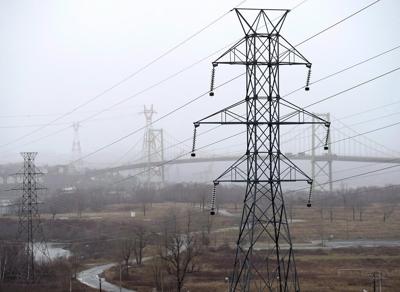HALIFAX - Nova Scotia's electric utility will lose control over who gets access to the power grid under a change the government says is needed to help the province reach its energy goals, including to stop using coal by 2030.
Natural Resources Minister Tory Rushton made the announcement on Friday, shortly after the two-member Clean Electricity Task Force released its report calling for the creation two new entities: an independent operator to control energy system planning, and an independent energy regulator.
“I can confirm that the government accepts the recommendation for a new Energy Modernization Act which I plan to table in the upcoming session of the legislature,” Rushton said in a news release.
Nova Scotia Power — a private company — will continue to exist but will no longer manage access to the power grid. That responsibility will now be in the hands of an independent system operator, with the goal of spurring the competition needed to replace coal, which currently accounts for about half of the province’s total electrical generation. The province has legislated a goal to get off coal by 2030.
The province's Utility and Review Board will also stay, but will be renamed the Nova Scotia Regulatory and Appeals Board to reflect its non-energy mandate. Its responsibilities over power will be transferred to the new Nova Scotia Energy Board, which would be responsible for electricity, natural gas, pipelines, regulation enforcement and retail gasoline.
Composed of former Nova Scotia deputy energy minister Alison Scott and former Nalcor Energy executive John MacIsaac, the task force was mandated by the provincial government in April 2023 to examine what the electrical system needs in order to meet the province’s environmental goals.
In an interview, Rushton welcomed their report and its major findings.
“This is a clear pathway to meet our targets for 2030 and the targets that are beyond for renewable reliable energy,” the minister said.
Rushton said it would take between 18 months and two years to get the two new bodies in place, adding that he would discuss the cost when the new legislation is tabled. And while he couldn’t speak about details he said the changes won't cost anyone their jobs.
“Anyone who works for Nova Scotia Power right now or the Utility and Review Board will be offered the same job when the transition takes place,” he said.
The report says the new system operator will "enhance" consumer confidence by placing electricity system decisions "in the expert hands of an independent system operator, at arm’s length from the corporate interest of (Nova Scotia Power)."
The report concludes that while the current Utility and Review Board operates well, its mandate is “far too broad” to deal effectively with long-term energy transition demands. It said the board currently deals with 40 Nova Scotia statutes that assign it regulatory responsibility. It points out that Alberta, Ontario and Quebec have independent energy regulators.
In a statement, Nova Scotia Power president Peter Gregg welcomed the report’s two key recommendations as “positive next steps” in the province’s transition to renewable energy. Gregg said a dedicated energy regulator will be important to advance critical projects, while a new system operator would allow the utility to focus on providing reliable service to customers and on delivering key projects.
“This includes grid-scale batteries and the new intertie (link) between Nova Scotia and New Brunswick,” Gregg said. “We will work with government on next steps to ensure that we all get this right for our customers.”
The task force makes 12 recommendations that include requiring Nova Scotia Power to formally submit an annual asset management plan for approval by the new regulator, and dedicated annual reports on vegetation management and wood pole management.
There are also recommendations for the government to evaluate Ontario’s energy subsidy programs to determine a “Made in Nova Scotia” set of measures to help with residential electricity costs, and to make upgrades to existing transmission grid infrastructure.
The report says estimates by engineering consultants Stantec placed transmission infrastructure costs at around $270 million in central and eastern Nova Scotia and at $664 million in the western part of the province.
Scott said that coal-fired power generation is expensive when compared to renewables such as wind.
“While we may have to spend on the grid to enable more renewables, the cost of generation we believe will more than offset that (investment),” Scott said.
This report by şĂÉ«tvwas first published Feb. 23, 2024.








































